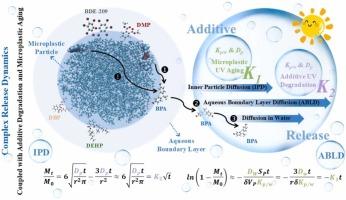Complex Release Dynamics of Microplastic Additives: An Interplay of Additive Degradation and Microplastic Aging
IF 12.2
1区 环境科学与生态学
Q1 ENGINEERING, ENVIRONMENTAL
引用次数: 0
Abstract
This study investigates the complex dynamics of additive release from microplastics in aquatic environments under natural ultraviolet (UV) radiation, which is critical for assessing ecotoxicological impacts and developing pollution remediation strategies. We focused on release kinetics of additives (Dimethyl phthalate (DMP), Dibutyl phthalate (DBP), Di(2-ethylhexyl) phthalate (DEHP), Bisphenol A (BPA) and Decabromodiphenyl ether (BDE-209)) from polyvinyl chloride (PVC), polyethylene (PE), and acrylonitrile-butadiene-styrene (ABS) microplastics exposed to UV light, exploring the interplay between additive release, photodegradation, and microplastic aging. Initial results showed a consistent release pattern, but under UV exposure, the release became more complex due to additive degradation and changes in the microplastics' structure. Factors such as polymer type, microplastic size, additive content, and environmental conditions (UV or darkness) significantly influenced the release quantity and kinetics. UV-induced additive degradation altered the concentration gradient between the microplastic and water, while aging, marked by changes in surface chemistry and internal polymer breakdown, accelerated additive release. By applying Inner Particle Diffusion (IPD) and Aqueous Boundary Layer Diffusion (ABLD) models, we demonstrated how UV-induced degradation and aging affected key parameters like the diffusion and partition coefficients, impacting the overall release process. These insights lay the foundation for understanding the environmental risks posed by microplastic additives and developing strategies to mitigate their impact in aquatic ecosystems.

求助全文
约1分钟内获得全文
求助全文
来源期刊

Journal of Hazardous Materials
工程技术-工程:环境
CiteScore
25.40
自引率
5.90%
发文量
3059
审稿时长
58 days
期刊介绍:
The Journal of Hazardous Materials serves as a global platform for promoting cutting-edge research in the field of Environmental Science and Engineering. Our publication features a wide range of articles, including full-length research papers, review articles, and perspectives, with the aim of enhancing our understanding of the dangers and risks associated with various materials concerning public health and the environment. It is important to note that the term "environmental contaminants" refers specifically to substances that pose hazardous effects through contamination, while excluding those that do not have such impacts on the environment or human health. Moreover, we emphasize the distinction between wastes and hazardous materials in order to provide further clarity on the scope of the journal. We have a keen interest in exploring specific compounds and microbial agents that have adverse effects on the environment.
 求助内容:
求助内容: 应助结果提醒方式:
应助结果提醒方式:


